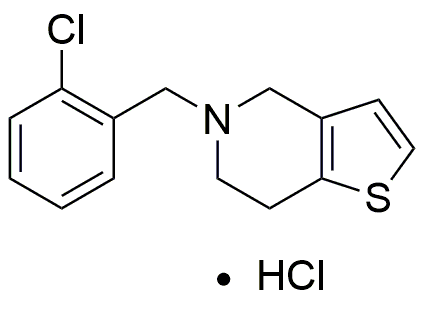Ticlopidine hydrochloride is widely utilized in research focused on
- Cardiovascular Medicine: It is primarily used as an antiplatelet agent to prevent blood clots in patients with a history of stroke or heart attack, making it essential in cardiology.
- Neurology: The compound is effective in reducing the risk of recurrent strokes, providing significant benefits for patients with transient ischemic attacks (TIAs).
- Clinical Research: Researchers often investigate its efficacy in combination therapies for various cardiovascular conditions, enhancing treatment protocols.
- Pharmaceutical Development: Ticlopidine hydrochloride serves as a model compound in the development of new antiplatelet drugs, aiding in the innovation of safer and more effective medications.
- Patient Management: It is used in managing patients undergoing stent placement, helping to improve outcomes and reduce complications associated with coronary interventions.
General Information
Properties
Safety and Regulations
Applications
Ticlopidine hydrochloride is widely utilized in research focused on
- Cardiovascular Medicine: It is primarily used as an antiplatelet agent to prevent blood clots in patients with a history of stroke or heart attack, making it essential in cardiology.
- Neurology: The compound is effective in reducing the risk of recurrent strokes, providing significant benefits for patients with transient ischemic attacks (TIAs).
- Clinical Research: Researchers often investigate its efficacy in combination therapies for various cardiovascular conditions, enhancing treatment protocols.
- Pharmaceutical Development: Ticlopidine hydrochloride serves as a model compound in the development of new antiplatelet drugs, aiding in the innovation of safer and more effective medications.
- Patient Management: It is used in managing patients undergoing stent placement, helping to improve outcomes and reduce complications associated with coronary interventions.
Documents
Safety Data Sheets (SDS)
The SDS provides comprehensive safety information on handling, storage, and disposal of the product.
Product Specification (PS)
The PS provides a comprehensive breakdown of the product’s properties, including chemical composition, physical state, purity, and storage requirements. It also details acceptable quality ranges and the product's intended applications.
Certificates of Analysis (COA)
Search for Certificates of Analysis (COA) by entering the products Lot Number. Lot and Batch Numbers can be found on a product’s label following the words ‘Lot’ or ‘Batch’.
*Catalog Number
*Lot Number
Certificates Of Origin (COO)
This COO confirms the country where the product was manufactured, and also details the materials and components used in it and whether it is derived from natural, synthetic, or other specific sources. This certificate may be required for customs, trade, and regulatory compliance.
*Catalog Number
*Lot Number
Safety Data Sheets (SDS)
The SDS provides comprehensive safety information on handling, storage, and disposal of the product.
DownloadProduct Specification (PS)
The PS provides a comprehensive breakdown of the product’s properties, including chemical composition, physical state, purity, and storage requirements. It also details acceptable quality ranges and the product's intended applications.
DownloadCertificates of Analysis (COA)
Search for Certificates of Analysis (COA) by entering the products Lot Number. Lot and Batch Numbers can be found on a product’s label following the words ‘Lot’ or ‘Batch’.
*Catalog Number
*Lot Number
Certificates Of Origin (COO)
This COO confirms the country where the product was manufactured, and also details the materials and components used in it and whether it is derived from natural, synthetic, or other specific sources. This certificate may be required for customs, trade, and regulatory compliance.


